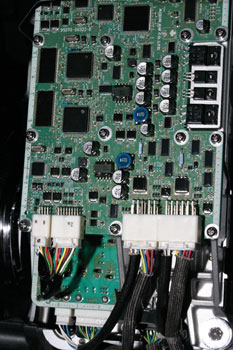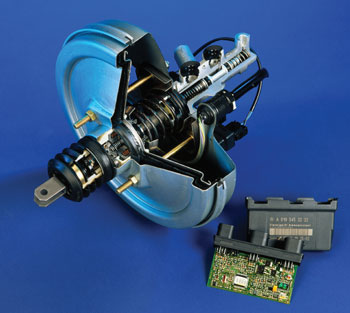
There are approximately 12 million “out of warranty” GM vehicles on the road today that can be flash programmed for update. From model year 2001 to 2005 there are more than 500 reprogrammable controllers, including brakes and traction control, of which two or more can be on an individual vehicle. As a business professional, there is a question that should be answered before investing in the hardware and subscriptions to perform reprogramming. Do you have a customer base that will support the cost of the hardware, subscriptions and training for reprogramming and provide a profit? If the answer is “No,” you will need to select a vendor that can supply a preprogrammed controller.
Since 1981, there has been a new station at the end of the assembly line. The Assembly Line Data Link (ALDL) connects the vehicle to a computer. This connection verifies that the Computer Command Control system and components are operating properly.
There could be one base Engine Control Module (ECM) for several engine types, each with the programming for a specific engine contained in a separate replaceable integrated circuit or “chip” called a Programmable Read Only Memory (PROM).
In the late 1980s, the manufacturers started equipping cars with anti-lock brakes. Many of these systems had a separate computer and ALDL and PROM.
Reprogramming these vehicles required replacing the PROM. In some cases, the entire ABS control unit needed to be replaced. This was a very costly fix for a software problem.
End-of-line repair technicians had access to hand-held devices that could read DTCs plus input and output information. The manufacturers of the end-of-line equipment saw the possibility of the hand-held device for use in dealerships. Tool and equipment manufacturers also saw the possibilities and began to produce scan tools for the OEs and the aftermarket.
In 1996, OBD II introduced flash programming through the use of the scan tool, eliminating the replacement of the PROM. The ALDL and other diagnostic connectors were replaced with an SAE standard J1962 16-pin Diagnostic Link Connector (DLC). Some ABS and traction control systems have kept their own ALDL, but these are becoming the exception rather than the rule.
Flash Drives
Flash reprogramming is made possible by the Electronically Erasable Program Read Only Memory (EEPROM). The EEPROM is an integrated circuit component of the controller. Today it is referred to as a flash drive. Flash drives have been incorporated into most controllers since 1996 and provide the ability to download new programming through the DLC or a direct connection to the controller.
Flash Programming 101
Reprogramming electronic control modules requires knowledge and experience to successfully use the internet to download programming data and transfer it to a vehicle controller. To perform reprogramming, your shop should be equipped with a broadband internet connection that offers speeds of up to 1.5Mbps or greater. Dial up isn’t going to cut it.
To download a program you will need a laptop or desktop computer with a processor speed of 1GHz or greater with Windows XP. My recommendation is that this machine be dedicated to diagnostics and reprogramming. A dedicated hard drive would also be a good idea. After logging in to a manufacturer’s website, a technician will need to navigate to the proper screens to obtain the information for the vehicle and to download the new flash program.
The most convenient means of reprogramming is the use of the DLC interface. This can be accomplished with a scan tool or an SAE J2534 pass-through interface.
Go to the web page and enter the VIN number. Compare the current calibration in the vehicle to the latest calibrations posted. In the case of vehicles utilizing a Controlled Area Network (CAN) buss circuit, one or more of its controllers may require reprogramming. Connect the scan tool or J2534 interface and compare the calibration information and download the required reprogramming updates.
Before you begin the reprogramming make sure the battery is fully charged. You do NOT want any loss of voltage as this can cause real problems. You can use a battery charger that is voltage regulated with a range of 13.2 to 14.1 volts to ensure that the download is successful.
Follow the instructions for the download. The download may contain a documentation file. Be sure to read and follow all instructions before you start the transfer of data. As the software is loaded, there will be a display showing the progress of the download. This reprogramming procedure may take up to 30 minutes or more depending on the file size. Note: The GM setup will NOT allow the same calibration to be reinstalled. Only an updated calibration can be downloaded into the vehicle controller. There will be a message when the program has been successfully downloaded.
After a successful download, there may be relearn procedures such as a “CASE” relearn for a GM PCM to learn the relative positions between the crankshaft and camshaft sensors. If you don’t do the CASE relearn, the Check Engine Light will come on and there will be a code P1336.
The vehicle should be taken for a test drive to check vehicle operation. The new program will have none of the learned memory from the old program and could require an extended drive time to relearn all functions such as block learn fuel control.
Reprogramming has been a part of maintenance and repair for more than 10 years and you probably have all of the equipment to perform the service. It is an opportunity to extend full service to your customer.











